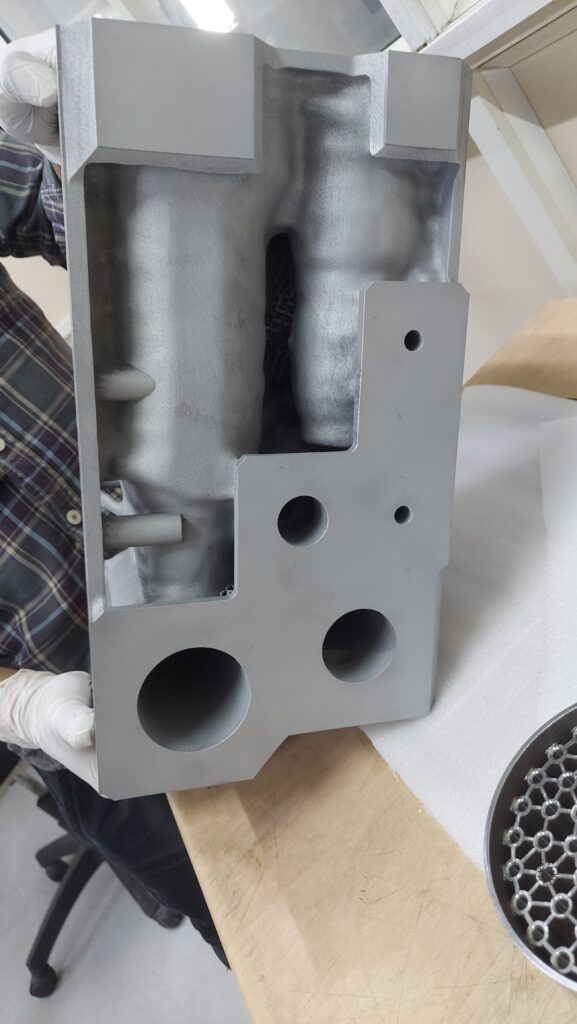
For the design and manufacture of hydraulic block manifolds, Additive Manufacturing (AM) is highly suited due to its ability to build internal features and passageways.
Objectify Technologies has collaborated with a customer to redesign their current hydraulic block manifold with AM in mind.
The 3D Printing project sought to reduce the weight of a component while retaining its robustness. Due to the increased design freedom associated with Additive Manufacturing (AM), an opportunity was identified to improve flow paths. Objectify Technologies optimised the given design by reducing weight while considering loading constraints.

The aerospace industry is the research, development, and manufacture of flight vehicles and space crafts. It produces Aeroplanes, spaceships, and other aerial vehicles. The industry also designs, assembles, and tests such vehicles. Technical innovation is a trademark of this industry.
What is a hydraulic block manifold?

Hydraulic Manifolds are used in the aerospace industry to regulate fluid flow. This helps us control the transfer of power between actuators, pumps, and other components in a hydraulic system.
Traditional manufacture of hydraulic block manifolds
Traditionally, hydraulic block manifolds have been manufactured from an aluminium alloy or stainless steel billet which has been cut and machined to size and drilled to create the flow pathways. Specialised tooling is often needed due to the complex drilling that is required. Passages require blanking plugs to properly direct flow through the system.
The nature of the manufacturing process leads to the formation of abrupt angled junctions between flow paths which causes flow separation and/or stagnation – a major contributor to efficiency loss.
What material is used to print the hydraulic block manifold?
The material used to build is an age-hardening cast aluminium alloy that provides good hardness, strength and dynamic toughness.
Aluminium alloy manifolds are generally less expensive to fabricate than stainless steel manifolds, and can be easily machined. However, because they are softer than stainless steel, aluminium can be worn away by loose particles in the flow. Stainless steel manifolds may cost more initially due to their higher material cost and machining complexity, but their higher hardness and density make them resistant to abrasion.
Advantages of AM for the design and manufacture of Hydraulic manifolds:
- Optimised flow paths increases efficiency of component functionality
- Need for fixturing is less
- Minimal requirement for removable support structures
- Significant weight reduction is achievable
- Block extraction passages are not required
- With full design freedom a manifold can be designed to pack into a significantly smaller volume
Direct benefits to customer:
- Mass reduction of up to 30%
- Single piece construction, fewer opportunities for defects
- Rapid design and development iterations
- Compatibility with existing design
- Improved flow efficiency of up to 60%
First design iteration

The previously provided part design is modified into a new one by design optimization by using simulation software –
RHINOCEROS 3D was used for Design Modification
MSC APEX was used for Design Optimization
MATERIALISE MAGICS was used for Data Preparation
SIMU FACT ADDITIVE was used for Build Simulation
By eliminating unnecessary drill channels and substituting them with simpler designs, critical areas can be modified and internal channels redesigned for manufacturability by 3-D printing in the considered orientation.

Results Summary
| Design Stage | Material | Mass (kg) |
| Original hydraulic manifold | Aluminium alloy | 21 |
| Design for AM | Aluminium alloy | 14.9 |
After analysis, the design was modified to improve its efficiency and strength. The new design was printed on a 3D printer and subjected to stress tests. The maximum stress observed on the component was 267 MPa. The original weight of the manifold was 21 kg; after optimization, we were able to reduce its weight by 6.1 kg — approximately 30% of its initial weight. The final weight after optimization was 14.9 kg.
Final changes were made to the design, and supports and stock material were added. The part was then fed into the 3D printer for printing.

After printing was completed and the part had cooled down, it was taken out and post processing activities began. Build Plate removal and manual powder removal took place next. Dimensions and quality checks came next, followed by an inspection for any defects in the print.

Thus, we were successfully able to create the hydraulic manifold which is more efficient, simpler structure and lighter in weight using Additive Manufacturing technology.


To find out how our Additive Manufacturing services can benefit you, please contact us. You can email your requirements to marketing@objectify.co.in.
Here is the link to our Hydraulic manifold video case study: https://www.youtube.com/watch?v=XkBVEQNPlqY
